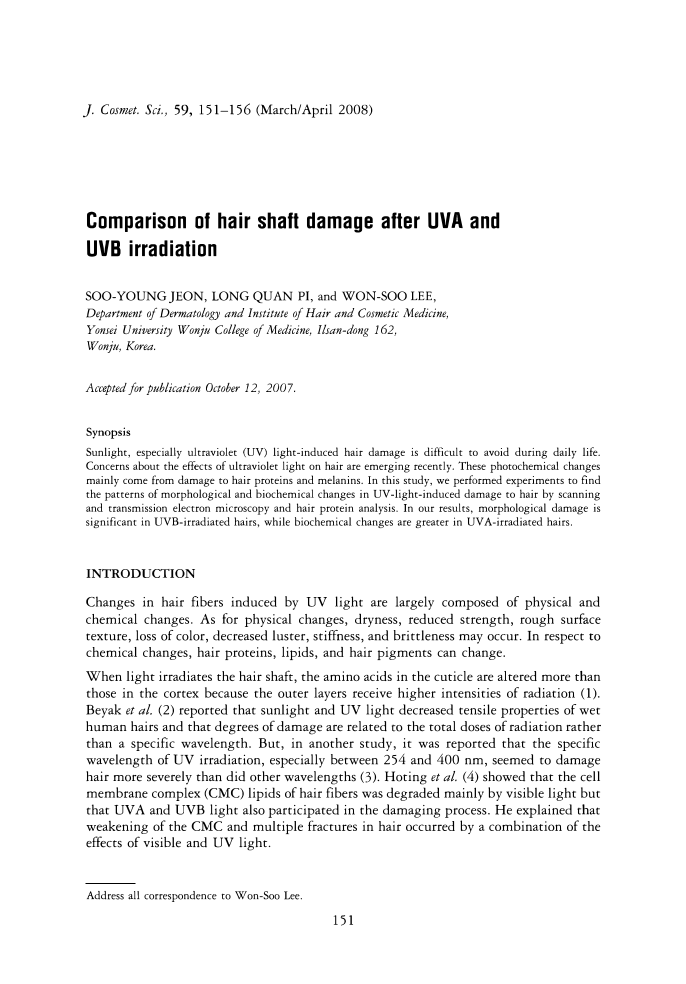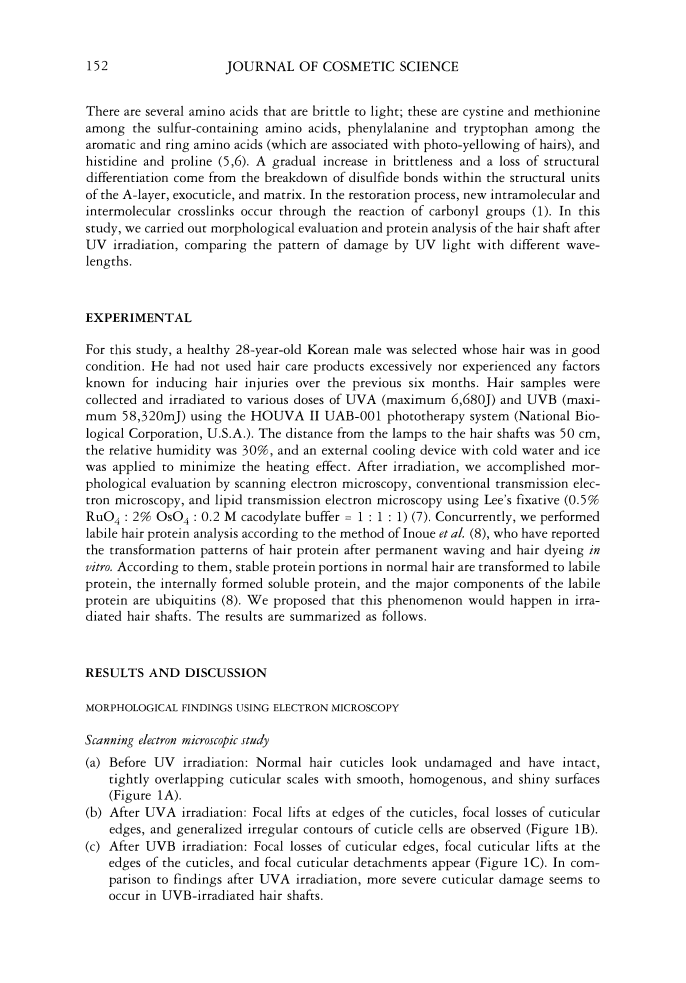J. Cosmet. Sci. 1 59, 151-156 (March/April 2008) Comparison of hair shaft damage after UVA and UVB irradiation SOO-YOUNG JEON, LONG QUAN PI, and WON-SOO LEE, Department of Dermatology and Institute of Hair and Cosmetic Medicine, Yonsei University Wonju College of Medicine, Ilsan-dong 162, Wonju, Korea. Accepted for publication October 12, 2007. Synopsis Sunlight, especially ultraviolet (UV) light-induced hair damage is difficult to avoid during daily life. Concerns about the effects of ultraviolet light on hair are emerging recently. These photochemical changes mainly come from damage to hair proteins and melanins. In this study, we performed experiments to find the patterns of morphological and biochemical changes in UV-light-induced damage to hair by scanning and transmission electron microscopy and hair protein analysis. In our results, morphological damage is significant in DVB-irradiated hairs, while biochemical changes are greater in UVA-irradiated hairs. INTRODUCTION Changes in hair fibers induced by UV light are largely composed of physical and chemical changes. As for physical changes, dryness, reduced strength, rough surface texture, loss of color, decreased luster, stiffness, and brittleness may occur. In respect to chemical changes, hair proteins, lipids, and hair pigments can change. When light irradiates the hair shaft, the amino acids in the cuticle are altered more than those in the cortex because the outer layers receive higher intensities of radiation (1). Beyak et al. (2) reported that sunlight and UV light decreased tensile properties of wet human hairs and that degrees of damage are related to the total doses of radiation rather than a specific wavelength. But, in another study, it was reported that the specific wavelength of UV irradiation, especially between 254 and 400 nm, seemed to damage hair more severely than did other wavelengths (3). Hoting et al. (4) showed that the cell membrane complex (CMC) lipids of hair fibers was degraded mainly by visible light but that UV A and UVB light also participated in the damaging process. He explained that weakening of the CMC and multiple fractures in hair occurred by a combination of the effects of visible and UV light. Address all correspondence to Won-Soo Lee. 151
152 JOURNAL OF COSMETIC SCIENCE There are several amino acids that are brittle to light these are cystine and methionine among the sulfur-containing amino acids, phenylalanine and tryptophan among the aromatic and ring amino acids (which are associated with photo-yellowing of hairs), and histidine and proline (5 ,6). A gradual increase in brittleness and a loss of structural differentiation come from the breakdown of disulfide bonds within the structural units of the A-layer, exocuticle, and matrix. In the restoration process, new intramolecular and intermolecular crosslinks occur through the reaction of carbonyl groups (1). In this study, we carried out morphological evaluation and protein analysis of the hair shaft after UV irradiation, comparing the pattern of damage by UV light with different wave- lengths. EXPERIMENT AL For this study, a healthy 28-year-old Korean male was selected whose hair was in good condition. He had not used hair care products excessively nor experienced any factors known for inducing hair injuries over the previous six months. Hair samples were collected and irradiated to various doses of UVA (maximum 6,680]) and UVB (maxi- mum 58,320mJ) using the HOUVA II UAB-001 phototherapy system (National Bio- logical Corporation, U.S.A.). The distance from the lamps to the hair shafts was 50 cm, the relative humidity was 30%, and an external cooling device with cold water and ice was applied to minimize the heating effect. After irradiation, we accomplished mor- phological evaluation by scanning electron microscopy, conventional transmission elec- tron microscopy, and lipid transmission electron microscopy using Lee's fixative (0.5% RuO4 : 2% OsO4 : 0.2 M cacodylate buffer == 1 : 1 : 1) (7). Concurrently, we performed labile hair protein analysis according to the method of Inoue et al. (8), who have reported the transformation patterns of hair protein after permanent waving and hair dyeing in vitro. According to them, stable protein portions in normal hair are transformed to labile protein, the internally formed soluble protein, and the major components of the labile protein are ubiquitins (8). We proposed that this phenomenon would happen in irra- diated hair shafts. The results are summarized as follows. RESULTS AND DISCUSSION MORPHOLOGICAL FINDINGS USING ELECTRON MICROSCOPY Scanning electron microscopic study (a) Before UV irradiation: Normal hair cuticles look undamaged and have intact, tightly overlapping cuticular scales with smooth, homogenous, and shiny surfaces (Figure lA). (b) After UVA irradiation: Focal lifts at edges of the cuticles, focal losses of cuticular edges, and generalized irregular contours of cuticle cells are observed (Figure lB). (c) After UVB irradiation: Focal losses of cuticular edges, focal cuticular lifts at the edges of the cuticles, and focal cuticular detachments appear (Figure lC). In com- parison to findings after UV A irradiation, more severe cuticular damage seems to occur in DVB-irradiated hair shafts.
Purchased for the exclusive use of nofirst nolast (unknown) From: SCC Media Library & Resource Center (library.scconline.org)






















































































